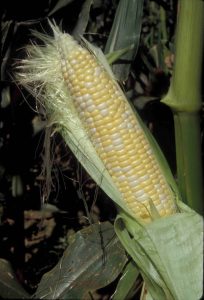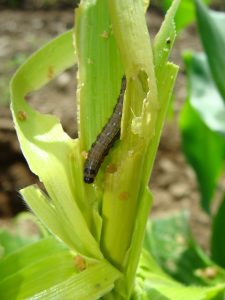Sweet Corn IPM Newsletter No. 10 – August 31, 2018
 Sweet Corn IPM Newsletter No. 10 – August 31, 2018
Sweet Corn IPM Newsletter No. 10 – August 31, 2018
Click on photos to enlarge.
CORN EARWORM, FALL ARMYWORM COUNTS LOWER
Most Silking Fields Still Require Protection
SITUATION
More hot, humid weather continues to push corn development ahead. Most remaining fields are silking or ready to harvest as the holiday weekend approaches. Insect pressure was more variable this week, with moth counts generally down, but still high enough to warrant protection in nearly all silking fields. Growers continue to report problems with worms getting through their spray programs.
European corn borer: Moth activity continues to decline this week. Moths were over the spray threshold for silking corn only in Sabattus, however this field was also on a spray interval for corn earworm. Feeding damage was very light, with no sites over the 15% spray threshold for pre-tassel to silking corn. Remember to plow down your corn stalks after harvest. Plowing down the stalks destroys overwintering sites for European corn borer.
Corn earworm: Moth counts were down in most locations this week, but most sites still require a regular spray interval for silking corn. A 6-day spray interval for silking corn was recommended for Dayton, one Lewiston site, and one Wells site. A 5-day spray interval was recommended for Biddeford, Levant, Nobleboro, North Berwick, Wayne and one Wells site. A 4-day spray interval was recommended for silking fields in Cape Elizabeth, Monmouth, New Gloucester, Poland Spring, and Sabattus.

Fall armyworm: Moth counts were lower in most locations this week, although many sites were still over the spray threshold for silking corn. Fields in Biddeford, Cape Elizabeth, Monmouth, New Gloucester, North Berwick, Oxford and Wayne were all over the three moths per week spray threshold for silking corn. However, with the exception of the Oxford site, all of them were already following a recommended spray interval for corn earworm. Some growers who have reported problems with getting good control of both fall armyworm and corn earworm with their typical insecticide (usually a pyrethroid, class 3A) have been trying products with different active ingredients, and finding improved control. Hot, sunny weather can significantly shorten the residual life of some pesticides, including pyrethroid types. Growers should consider shortening the spray application interval or rotating to a different chemical class if corn is infested despite control efforts.
There’s still time for cover crops!
Plowing down corn stalks and stubble is an important means of managing European corn borer by destroying their over wintering sites. However, late plowing can leave soil exposed and prone to erosion during the winter and spring. Planting winter rye is a good alternative for many fields. Winter rye can often be planted well into September and still produce enough of a cover to prevent erosion. This grass will survive the winter and put on more growth in the early spring. It should be killed by plowing, mowing or herbicide before it goes to seed. Bear in mind that having rye on the field may delay planting in the spring, as you must wait for conditions to be warm and dry enough to plow it in.
Sincerely,
David T. Handley
Vegetable and Small Fruit Specialist
Highmoor Farm, P.O. Box 179, 52 US Route 202, Monmouth, ME 04259, 207.933.2100
UMaine Extension Diagnostic Research Lab, Pest Management Unit, 17 Godfrey Drive, Orono, ME 04473, 1.800.287.0279
| Location | CEW Moths |
ECB Moths |
FAW Moths |
% Feeding Damage |
Recommendations/Comments |
|---|---|---|---|---|---|
| Biddeford | 7 | 0 | 7 | 4% | 5-day spray interval recommended on all silking corn |
| Bowdoinham | 0 | 0 | 0 | 0% | No spray recommended |
| Cape Elizabeth I | 19 | 0 | 12 | 4-day spray interval recommended on all silking corn | |
| Cape Elizabeth II | 26 | 2 | 4 | 4-day spray interval recommended on all silking corn | |
| Charleston | 1 | 0 | 0 | No spray recommended | |
| Corinth | 1 | 0 | 1 | No spray recommended | |
| Dayton | 2 | 0 | 1 | 6-day spray interval recommended on all silking corn | |
| Farmington | 1 | 0 | 0 | No spray recommended | |
| Levant | 6 | 1 | 1 | 5-day spray interval recommended on all silking corn | |
| Lewiston I | 3 | 0 | 0 | 6-day spray interval recommended on all silking corn | |
| Lewiston II | 1 | 0 | 0 | No spray recommended | |
| Monmouth | 13 | 7 | 4-day spray interval recommended on all silking corn | ||
| New Gloucester | 16 | 0 | 5 | 4-day spray interval recommended on all silking corn | |
| Nobleboro | 4 | 0 | 1 | 5-day spray interval recommended on all silking corn | |
| North Berwick | 5 | 0 | 6 | 0% | 5-day spray interval recommended on all silking corn |
| Oxford | 0 | 0 | 17 | 20% | Spray recommended for FAW |
| Palmyra | 0 | 0 | 0 | No spray recommended | |
| Poland Spring | 37 | 0 | 1 | 4-day spray interval recommended on all silking corn | |
| Sabattus | 9 | 9 | 0 | 4-day spray interval recommended on all silking corn | |
| Wayne | 6 | 0 | 3 | 5-day spray interval recommended on all silking corn | |
| Wells I | 2 | 0 | 0 | 6-day spray interval recommended on all silking corn | |
| Wells II | 4 | 1 | 1 | 5-day spray interval recommended on all silking corn |
CEW: Corn earworm (Only fresh silking corn should be sprayed for this insect.)
ECB: European corn borer
FAW: Fall armyworm
| Moths caught per week | Moths caught per night | Spray interval |
|---|---|---|
| 0.0 to 1.4 | 0.0 to 0.2 | No spray |
| 1.5 to 3.5 | 0.3 to 0.5 | Spray every 6 days |
| 3.6 to 7.0 | 0.6 to 1.0 | Spray every 5 days |
| 7.1 to 91 | 1.1 to 13.0 | Spray every 4 days |
| More than 91 | More than 13 | Spray every 3 days |
Thresholds apply only to corn with exposed fresh silk. Lengthen spray intervals by one day if maximum daily temperature is less than 80°F.
European Corn Borer Thresholds
Whorl stage: 30% or more of plants scouted show injury.
Pre-tassel-silk: 15% or more of plants scouted show injury.
Silk: 5 or more moths caught in pheromone traps in one week.
IPM Web Pages:
UMaine Cooperative Extension Integrated Pest Management
UMass Amherst Integrated Pest Management
Where brand names or company names are used, it is for the reader’s information. No endorsement is implied nor is any discrimination intended against other products with similar ingredients. Always consult product labels for rates, application instructions and safety precautions. Users of these products assume all associated risks.
The University of Maine is an equal opportunity/affirmative action institution.
